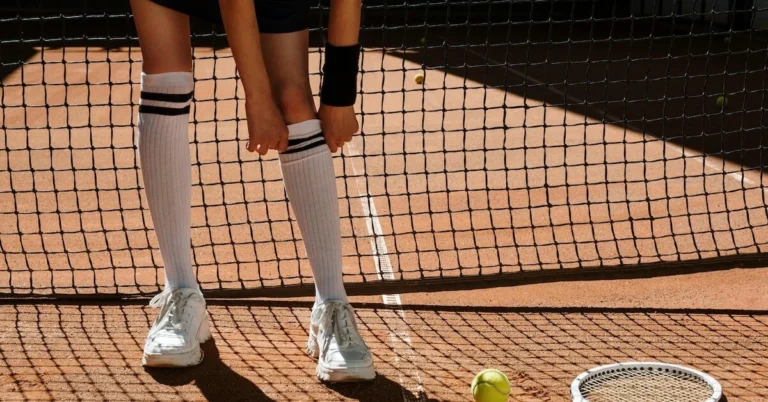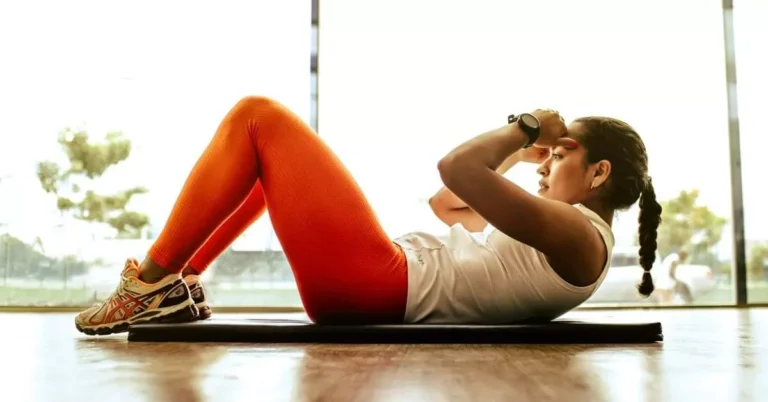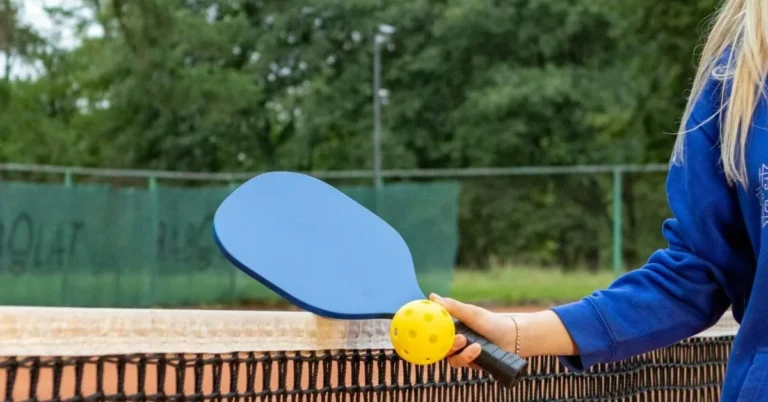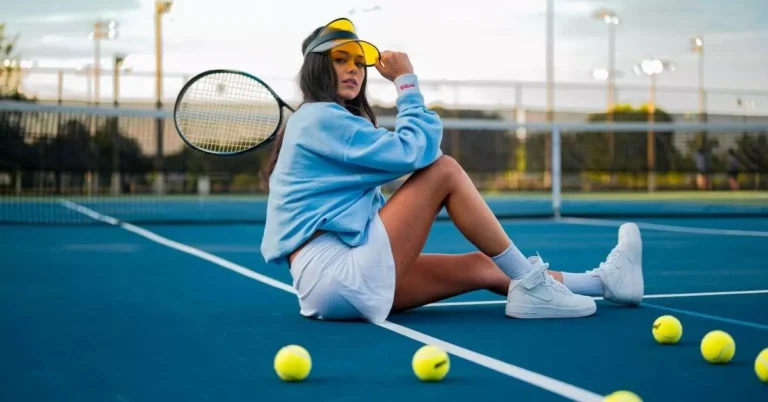If you’re a parent or a coach of a young tennis player, you may be wondering when it’s time for your child to switch to a bigger tennis racket. Tennis rackets come in various sizes and weights, and it’s important to find the right one for your child’s age, height, and skill level.
The general rule of thumb is that children should switch to a bigger tennis racket when they outgrow their current one. However, this can vary depending on the child’s physical development, playing style, and goals. For example, a child who is tall for their age and has good hand-eye coordination may be ready for a bigger tennis racket earlier than a child who is shorter and less coordinated.
Switching to a bigger tennis racket too soon can lead to poor technique, as the child may struggle to control the heavier racket. On the other hand, using a racket that is too small can limit a child’s potential and hinder their progress. It’s important to find the right balance and make the switch at the appropriate time. In the following sections, we’ll explore the factors to consider when deciding when to switch to a bigger tennis racket.
Pro:
✅ best all-rounder ✅ stability ✅ high support
Con:
❌ maybe you need some time to get used to it
Understanding Tennis Racket Sizes
Choosing the right tennis racket size for your child is essential to their success in the sport. A racket that is too small or too large can hinder your child’s performance and even lead to injury. Here’s what you need to know about tennis racket sizes:
Junior Rackets
Junior rackets are designed specifically for children and come in a range of sizes. The correct size of a junior racket is determined by the child’s age and height. For children aged 8 and below, rackets ranging from 19 to 23 inches are ideal, with heights ranging from 3′ 75″ – 4 feet (approximately 114 – 124 cm) and below. For children aged 8-10 years old, rackets ranging from 23 to 25 inches are typically used, with heights ranging from 4 feet to 4′ 6″ feet (124 – 140 cm).
Adult-Sized Rackets
Once your child has outgrown their junior racket, it’s time to consider an adult-sized racket. However, it’s important to ensure that the racket is not too large. Oversized rackets can cause injury and hinder your child’s performance. A mid-plus racket is a good option for most players, as it provides a balance of power and control.
Choosing the Correct Size
To determine the correct size of a tennis racket for your child, measure their height and refer to a size chart. It’s important to note that the size chart is just a guide, and your child’s personal preference and playing style should also be taken into consideration. When choosing a racket, make sure your child can comfortably hold the racket and swing it without any restrictions.
Upgrade to a Bigger Tennis Racket: Child Development and Racket Size
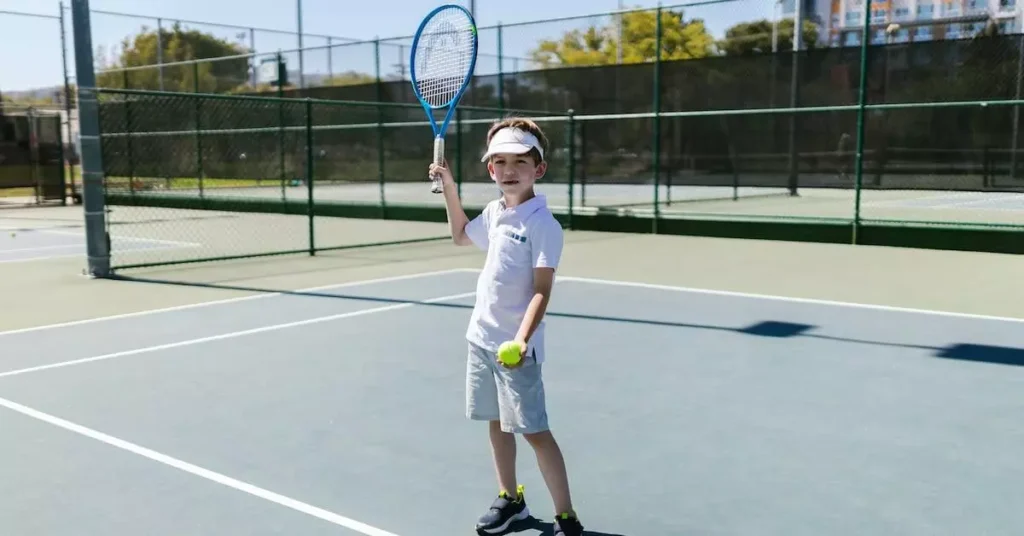
Switching to a bigger tennis racket depends on several factors, including your child’s age, height, weight, and skill level.
Children grow rapidly, and their bodies change quickly. During growth spurts, it is common for children to experience a temporary decrease in coordination and balance. This can make it challenging for them to handle a larger racket. Therefore, it is important to choose a racket that is appropriate for your child’s size and skill level.
Junior players typically start with smaller rackets that are easier to handle. These rackets are designed to help young players develop their technique and coordination. As your child grows and gains experience, they may need a larger racket to accommodate their increasing strength and skill level.
When choosing a racket for your child, consider their height and weight. A taller and heavier child may need a larger racket than a shorter and lighter child. It is also important to choose a racket with the appropriate grip size. A racket with a grip that is too small or too large can affect your child’s performance and increase their risk of injury.
In general, children between the ages of 3 and 5 should use a racket that is 19 to 21 inches long. Children between the ages of 6 and 8 should use a racket that is 23 to 25 inches long. Children between the ages of 9 and 12 should use a racket that is 26 inches long. When your child reaches their teenage years, they may be ready to switch to an adult-sized racket.
Upgrade to a Bigger Tennis Racket: Tennis Racket Features
When it comes to selecting the right tennis racket for your child, there are several features to consider. These features include grip, grip size, head size, frame, length, weight, materials, technology, string pattern, and tension.
Grip and Grip Size
The grip is the part of the racket that you hold onto while playing. It is essential to choose a grip that is comfortable and suits the size of your child’s hand. The grip size should be appropriate to ensure that your child can hold the racket comfortably and firmly. A grip that is too small or too big can cause discomfort and affect your child’s performance.
Head Size
The head size of a tennis racket refers to the size of the racket face. Generally, a larger head size provides a larger sweet spot, which makes it easier to hit the ball. For younger children, a smaller head size is recommended as it provides better control and maneuverability.
Frame, Length, and Weight
The frame, length, and weight of the racket are important factors to consider when selecting a tennis racket for your child. A lightweight racket is easier to maneuver and swing, making it ideal for younger children. The length of the racket should be appropriate for your child’s size and age. A shorter racket is recommended for younger children, while a longer racket is suitable for older children.
Materials and Technology
The materials used to make a tennis racket can affect its performance and durability. Rackets made from graphite or composite materials are lighter and more durable than those made from aluminum or wood. Additionally, rackets with advanced technology can provide more power and control, making them ideal for older children.
String Pattern and Tension
The string pattern and tension of a tennis racket can affect the amount of power and control your child has when hitting the ball. A tighter string tension provides more control, while a looser tension provides more power. Additionally, a dense string pattern provides more control, while an open string pattern provides more power.
Upgrade to a Bigger Tennis Racket: Selecting the Correct Racket Size
The right racket size will ensure that they have the correct fit, comfort, and control while playing. Here are the most important factors to consider when selecting the correct racket size for your child.
Skill Level and Playing Style
Your child’s skill level and playing style are also important factors to consider when selecting the correct racket size. If your child is a beginner, they should use a lighter racket with a larger sweet spot to help them learn proper technique and swing. As they progress, they can switch to a heavier racket with a smaller sweet spot to gain more control and power.
Technique and Swing Shape
Your child’s technique and swing shape are also important factors to consider when selecting the correct racket size. If your child has a shorter swing, they should use a shorter racket to help them generate more power. If they have a longer swing, they should use a longer racket to help them gain more control.
Balance and Power
The balance and power of the racket are also important factors to consider when selecting the correct racket size. A balanced racket will help your child achieve a comfortable swing, while a head-heavy racket will help them generate more power.
Transitioning to a Bigger Tennis Racket
Upgrading to a bigger tennis racket can help a child hit the ball with more power and spin, but it’s important to make the transition at the right time to avoid negative effects on their game.
First and foremost, you should consider your child’s age and size. A good time to switch to an adult racket is when a child starts being comfortable with hitting green balls or is making the transition into using full yellow balls, which is usually around 10 to 12 years old. However, this can vary depending on the child’s development and experience with the game.
It’s important to note that switching to a bigger tennis racket can be a difficult transition for some children. As Play Tennis explains, “The switch is a significant milestone in a young player’s journey, often symbolizing their evolution from a beginner to a more advanced player.” It’s important to prepare your child for this transition and help them adjust to the new racket.
When making the transition, it’s important to focus on developing good habits with the new racket. According to Talk Tennis, “It’s important to make sure that your child is using proper technique when hitting with the new racket, as it can be easy to fall into bad habits when using a different racket.” Encourage your child to focus on proper technique and form, and work with a coach if necessary to ensure they are developing good habits with the new racket.
Transitioning to a bigger tennis racket can be an important step in a child’s development as a player. It’s important to consider your child’s age and size, prepare them for the transition, and focus on developing good habits with the new racket. With the right approach, your child can successfully make the transition and continue to improve their game.
Recommended Racket Sizes for Different Age Groups
It is important to select an ideal racket that is proportionate to your child’s age and height to ensure maximum comfort and performance.
Here are some recommended racket sizes for different age groups:
- Ages 3-4: Children in this age group should use a 19-21 inch racket. These rackets are lightweight and easy to maneuver, making them perfect for young children who are just starting to play tennis.
- Ages 5-6: For children aged 5-6 years old, a 21-23 inch racket is ideal. These rackets are slightly bigger and provide more power and control, which is necessary for children who are starting to develop their skills.
- Ages 7-8: Children aged 7-8 years old should use a 23-25 inch racket. These rackets are bigger and heavier, providing more power and control for more advanced players.
- Ages 9-10: For children aged 9-10 years old, a 25-26 inch racket is recommended. These rackets are even bigger and heavier, providing maximum power and control for more advanced players.
- Ages 11 and above: Children aged 11 and above should use a standard adult-sized racket, which is typically 27 inches long. These rackets are designed for maximum power and control and are suitable for more advanced players.
It is important to note that these are just general guidelines, and the ideal racket size for your child may vary depending on their height, weight, and skill level. If you are unsure about which racket size is best for your child, consult with a coach or tennis professional for further guidance.
Role of Coaching in Racket Selection
While age is a good indicator, it’s not the only factor to consider. The role of coaching in racket selection is crucial to ensure that your child is using the right equipment for their level of play.
A good coach will take into account your child’s height, strength, technique, and playing style when recommending a racket size. They will also consider the type of tennis your child is playing, whether it’s recreational or competitive, and whether it’s for fun or to improve their skills.
When it comes to recreational play, the focus is on having fun and developing a love for the game. In this case, a smaller racket might be more appropriate for younger children as it’s easier to handle and control. However, as they grow and develop their skills, a bigger tennis racket might be necessary to help them hit the ball with more power and accuracy.
On the other hand, if your child is playing competitively, a bigger tennis racket might be necessary to keep up with the demands of the game. A coach can help your child select a racket that will give them an edge on the court and improve their overall performance.
If you don’t already have a coach or are unhappy with your current one, you are welcome to read my article on how to find a great coach.
Injury Prevention and Racket Size
Injury prevention is a crucial aspect of tennis, especially when it comes to children. One of the most important factors in injury prevention is selecting the right size racket. Using a racket that is too big or too small can lead to injuries, particularly in the wrist and elbow.
When it comes to selecting the right size racket for a child, it’s important to consider their age, height, and skill level. A racket that is too heavy or too long can put undue strain on a child’s arm, leading to injuries. On the other hand, a racket that is too small can lead to poor technique and a lack of power, which can also increase the risk of injury.
To help ensure that your child is using the right size racket, it’s important to consult a sizing chart and take into account their height and skill level. For example, a child who is between 4 and 5 years old and is just starting to play tennis should use a racket that is between 19 and 21 inches in length. As they grow and develop their skills, they can gradually move up to larger rackets.
It’s also important to consider the weight of the racket. A heavier racket can provide more power, but it can also put more strain on the arm. A lighter racket, on the other hand, may not provide as much power, but it can be easier to maneuver and less likely to cause injury.
FAQ
At what age should a child switch to a bigger tennis racket?
The age at which a child should switch to a bigger tennis racket depends on various factors such as the child’s height, strength, and skill level. A child can switch to an adult-sized racket when he or she is around 11 years old. However, this is just a general guideline, and it is important to consider the child’s individual needs and abilities.
What is the recommended size of a tennis racket for a 10-year-old?
The recommended size of a tennis racket for a 10-year-old depends on the child’s height and skill level. A 10-year-old who is between 55-60 inches tall should use a racket that is 26 inches long. However, if the child is taller or more advanced in skill, a 27-inch racket may be more appropriate.
How do I know if my child needs a bigger tennis racket?
You can tell if your child needs a bigger tennis racket if he or she is struggling to generate power or control with their current racket. Additionally, if your child is hitting the ball late or struggling to reach the ball, it may be a sign that they need a bigger tennis racket. You can also check if the racket handle fits comfortably in your child’s hand. If the handle is too small or too big, it may be time to switch to a different size.
Are there any disadvantages to using a tennis racket that is too small for a child?
Using a tennis racket that is too small for a child can hinder their progress and development in the sport. A racket that is too small can cause the child to develop poor technique and limit their ability to generate power and control. Additionally, using a racket that is too small can increase the risk of injury, as the child may have to overcompensate for the lack of power and control.
As you guide your young tennis star through the exhilarating journey of upgrading to a bigger tennis racket, we’d love to hear about your experiences and insights. Have you faced any challenges or witnessed remarkable improvements? Share your thoughts in the comments below.
If you want to know how you can best support your child with tennis, read on here.




